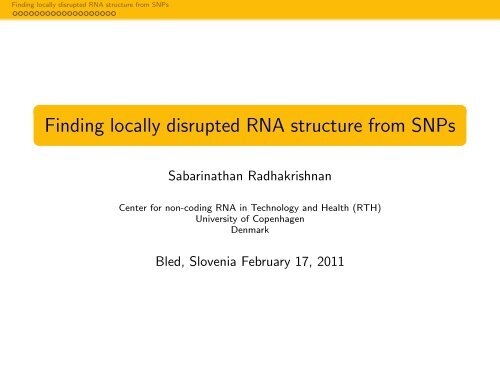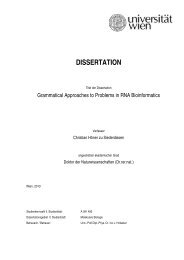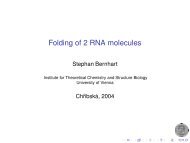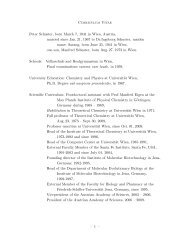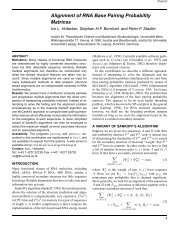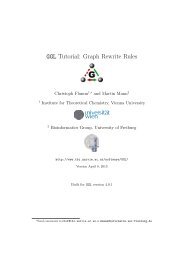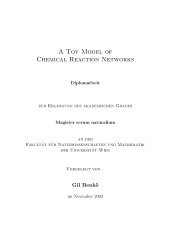Finding locally disrupted RNA structure from SNPs - TBI
Finding locally disrupted RNA structure from SNPs - TBI
Finding locally disrupted RNA structure from SNPs - TBI
You also want an ePaper? Increase the reach of your titles
YUMPU automatically turns print PDFs into web optimized ePapers that Google loves.
<strong>Finding</strong> <strong>locally</strong> <strong>disrupted</strong> <strong>RNA</strong> <strong>structure</strong> <strong>from</strong> <strong>SNPs</strong><br />
<strong>Finding</strong> <strong>locally</strong> <strong>disrupted</strong> <strong>RNA</strong> <strong>structure</strong> <strong>from</strong> <strong>SNPs</strong><br />
Sabarinathan Radhakrishnan<br />
Center for non-coding <strong>RNA</strong> in Technology and Health (RTH)<br />
University of Copenhagen<br />
Denmark<br />
Bled, Slovenia February 17, 2011
<strong>Finding</strong> <strong>locally</strong> <strong>disrupted</strong> <strong>RNA</strong> <strong>structure</strong> <strong>from</strong> <strong>SNPs</strong><br />
Outline<br />
Introduction<br />
Motivation<br />
Local <strong>structure</strong> comparison<br />
Results<br />
Further work
<strong>Finding</strong> <strong>locally</strong> <strong>disrupted</strong> <strong>RNA</strong> <strong>structure</strong> <strong>from</strong> <strong>SNPs</strong><br />
DISEASE by <strong>RNA</strong><br />
Disease associated mutations are ofenly identified in intergenic and<br />
non-coding regions - Genome-wide association studies (GWAS)<br />
95% of the human genome are transcribed and of possible mutation<br />
carriers<br />
SNP induced structural changes in the regulatory <strong>RNA</strong>s of the<br />
human genome results in disease phenotype (Hyperferritinemia<br />
Catarct Syndrome, Retinoblastoma, etc.,)<br />
Also, it alters the function of replication and translation (Hepatitis C<br />
Virus) and resistance against antibiotics (Bacteria)
<strong>Finding</strong> <strong>locally</strong> <strong>disrupted</strong> <strong>RNA</strong> <strong>structure</strong> <strong>from</strong> <strong>SNPs</strong><br />
Existing algorithms and database<br />
Resources: <strong>RNA</strong>mute (Churkin and Barash, 2006; 2008), RDMAS<br />
(Shu et al., 2006) <strong>RNA</strong>mutants (Waldispuhl et al., 2008; 2009),<br />
SNPfold (Halvorsen et al., 2010)<br />
Efficiency: Handles Single Point Mutations / Multiple Point<br />
Mutations<br />
Function: Measures Global structural changes in <strong>RNA</strong>(Ensemble)<br />
induced by the SNP<br />
Biological relevance: Majority of mutations have small, local<br />
effects on the <strong>structure</strong> ensemble, while certain specific mutations<br />
can profoundly alter it (Halvorsen et al., 2010)<br />
Requirement (??): Program to explore the local regions (may be<br />
<strong>RNA</strong> functional elements) distrupted by <strong>SNPs</strong> in regulatory <strong>RNA</strong>’s
<strong>Finding</strong> <strong>locally</strong> <strong>disrupted</strong> <strong>RNA</strong> <strong>structure</strong> <strong>from</strong> <strong>SNPs</strong><br />
Global <strong>structure</strong> comparison<br />
Comparing base pair probability matrices<br />
Two sequences A (wild type) and B(mutant) with identical length<br />
Base pair probability P A and P B - partition function (<strong>RNA</strong>fold)<br />
p(i) A = ∑ N A<br />
j=1 PA ij and p(k) B = ∑ N B<br />
r = corr(Ψ A ij and Ψ B kl ) where ΨA ij<br />
j=1 PB kl<br />
= {p(i),p(i+1),...,p(j)} and Ψ B kl<br />
= {p(k),p(k+1),...,p(l)}
<strong>Finding</strong> <strong>locally</strong> <strong>disrupted</strong> <strong>RNA</strong> <strong>structure</strong> <strong>from</strong> <strong>SNPs</strong><br />
Problems<br />
Correlation coeffecient is inversly proportional to sequence length<br />
Local <strong>structure</strong> comparison - time consuming
<strong>Finding</strong> <strong>locally</strong> <strong>disrupted</strong> <strong>RNA</strong> <strong>structure</strong> <strong>from</strong> <strong>SNPs</strong><br />
Local <strong>structure</strong> comparison<br />
Accumulated Score matrix<br />
pseudocode<br />
upper diagonal<br />
for (j > i):<br />
A ij = A ij−1 + P A ij<br />
lower diagonal<br />
for (j < i):<br />
A ij = A ij+1 + P A ij
<strong>Finding</strong> <strong>locally</strong> <strong>disrupted</strong> <strong>RNA</strong> <strong>structure</strong> <strong>from</strong> <strong>SNPs</strong><br />
Local <strong>structure</strong> comparison<br />
Comparing base pair probability matrices<br />
pseudocode<br />
len = length of sequence<br />
for i = 0 to len<br />
for j = len to i+1<br />
for m = i to j<br />
PA[m]=A[m,j] + A[m,i]<br />
push(PAs,PA[i])<br />
PB[m]=B[m,j] + B[m,i]<br />
push(PB’,PB[i])<br />
endfor<br />
r(i,j) = corr(PAs,PBs)<br />
endfor<br />
endfor
<strong>Finding</strong> <strong>locally</strong> <strong>disrupted</strong> <strong>RNA</strong> <strong>structure</strong> <strong>from</strong> <strong>SNPs</strong><br />
Material<br />
Data Description<br />
Genome scan of all known disease-associated <strong>SNPs</strong> in Human Gene<br />
Mutation Database (HGMD)<br />
514 disease-associated <strong>SNPs</strong> in 350 regulatory <strong>RNA</strong>s (Halvorsen et<br />
al., 2010)<br />
Of these, 206 - 5’UTRs, 132 - 3’UTRS and 12 - nc<strong>RNA</strong>s<br />
<strong>SNPs</strong> were mapped only to the untranslated regions of mature<br />
m<strong>RNA</strong> and are at least 10nt away <strong>from</strong> any transcription or<br />
translation start or stop sites.
<strong>Finding</strong> <strong>locally</strong> <strong>disrupted</strong> <strong>RNA</strong> <strong>structure</strong> <strong>from</strong> <strong>SNPs</strong><br />
Results of global comparison<br />
Impact of <strong>SNPs</strong> in <strong>RNA</strong> <strong>structure</strong><br />
Among the 514 disease-associated <strong>SNPs</strong>, majority of <strong>SNPs</strong> impart less<br />
global conformational changes (r = 0.9 - 1), that represents the impact<br />
of local conformational changes in regulatory <strong>RNA</strong>s
<strong>Finding</strong> <strong>locally</strong> <strong>disrupted</strong> <strong>RNA</strong> <strong>structure</strong> <strong>from</strong> <strong>SNPs</strong><br />
Results of global comparison
<strong>Finding</strong> <strong>locally</strong> <strong>disrupted</strong> <strong>RNA</strong> <strong>structure</strong> <strong>from</strong> <strong>SNPs</strong><br />
Results of global comparison<br />
Analysis of SNP’s in selective <strong>RNA</strong>s<br />
Result of global <strong>structure</strong> comparison <strong>from</strong> all (N X 3) possible <strong>SNPs</strong> in a<br />
<strong>RNA</strong>. The selective <strong>RNA</strong>s given below are the ones having higher number<br />
(> 10) of known <strong>SNPs</strong> <strong>from</strong> HGMD, that are profoundly associated with<br />
local conformational changes (highlighted in red triangle)
<strong>Finding</strong> <strong>locally</strong> <strong>disrupted</strong> <strong>RNA</strong> <strong>structure</strong> <strong>from</strong> <strong>SNPs</strong><br />
Results of global comparison<br />
Analysis of SNP’s in selective <strong>RNA</strong>s
<strong>Finding</strong> <strong>locally</strong> <strong>disrupted</strong> <strong>RNA</strong> <strong>structure</strong> <strong>from</strong> <strong>SNPs</strong><br />
Local <strong>structure</strong> comparison<br />
Case study: Hyperferritinemia Cataract Syndrome<br />
Hereditary Hyperferritinimeia Cataract Syndrome is an autosomic<br />
dominant disorder caused by heterogeneous mutations on the<br />
iron-responsive element (IRE) of ferritin L-chain m<strong>RNA</strong>.<br />
The mutations in 5’UTR regions distrubs the <strong>structure</strong> of IRE which<br />
alters the binding affinity of IRP (Iron Response Protein) leading to<br />
aberrant FTL regulation.<br />
In wildtype sequence, the position of IRE element is predicted<br />
between 30 to 52 bases using UTRscan.
<strong>Finding</strong> <strong>locally</strong> <strong>disrupted</strong> <strong>RNA</strong> <strong>structure</strong> <strong>from</strong> <strong>SNPs</strong><br />
Local <strong>structure</strong> comparison<br />
Selecting some known <strong>SNPs</strong> to analyse <strong>locally</strong> distrupted regions using<br />
the proposed method
<strong>Finding</strong> <strong>locally</strong> <strong>disrupted</strong> <strong>RNA</strong> <strong>structure</strong> <strong>from</strong> <strong>SNPs</strong><br />
Results of local <strong>structure</strong> comparison<br />
Hyperferritinemia Cataract Syndrome (Gene: FTL/5’UTR)<br />
G41C<br />
C39G<br />
Global=0.999<br />
Local=0.342 (sub<strong>structure</strong>:1-42)<br />
Global=0.862<br />
Local=0.247 (sub<strong>structure</strong>: 1-40)
<strong>Finding</strong> <strong>locally</strong> <strong>disrupted</strong> <strong>RNA</strong> <strong>structure</strong> <strong>from</strong> <strong>SNPs</strong><br />
Results of local <strong>structure</strong> comparison<br />
Hyperferritinemia Cataract Syndrome (Gene: FTL/5’UTR)<br />
T22G<br />
C14G<br />
Global=0.764<br />
Local=0.221 (sub<strong>structure</strong>: 1-72)<br />
Global=0.670<br />
Local=0.375 (sub<strong>structure</strong>: 1-139)
<strong>Finding</strong> <strong>locally</strong> <strong>disrupted</strong> <strong>RNA</strong> <strong>structure</strong> <strong>from</strong> <strong>SNPs</strong><br />
Hyperferritinemia Cataract Syndrome (Gene: FTL/5’UTR)
<strong>Finding</strong> <strong>locally</strong> <strong>disrupted</strong> <strong>RNA</strong> <strong>structure</strong> <strong>from</strong> <strong>SNPs</strong><br />
Further work<br />
More !! to do..<br />
Test with more data’s for Optimization<br />
Extend this method to identify the impact of <strong>SNPs</strong> in <strong>RNA</strong> <strong>structure</strong><br />
prediction <strong>from</strong> multiple sequence alignment<br />
Genome wide study of SNP associated phenotypes in PIG Genome
<strong>Finding</strong> <strong>locally</strong> <strong>disrupted</strong> <strong>RNA</strong> <strong>structure</strong> <strong>from</strong> <strong>SNPs</strong><br />
Acknowledgement<br />
Jan Gorodkin<br />
Stefan and other colleagues of RTH group<br />
Faculty of Life Sciences, KU<br />
Alain Laederach
<strong>Finding</strong> <strong>locally</strong> <strong>disrupted</strong> <strong>RNA</strong> <strong>structure</strong> <strong>from</strong> <strong>SNPs</strong><br />
Thank you for your attention


